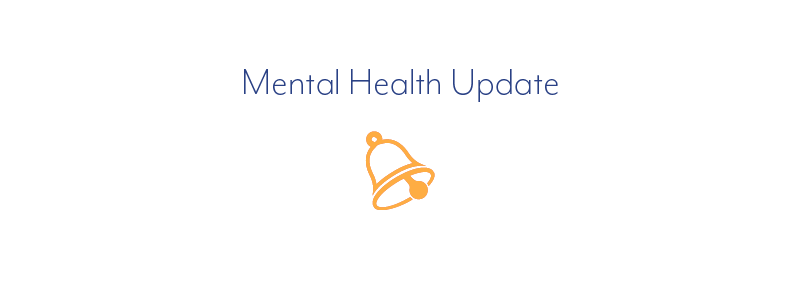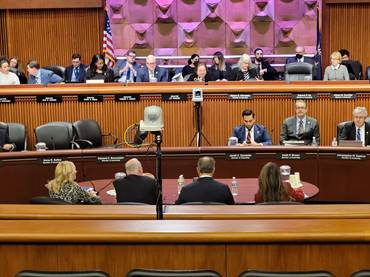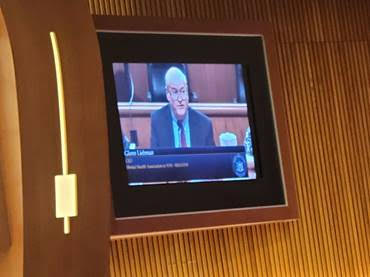Mental Health Update

Testimonial for NYS Legislature Joint Budget Hearing on Mental Hygiene
Listed below is MHANYS Testimony today to the Senate Finance and Assembly Ways and Means Committee on Mental Hygiene. The best way to characterize today’s hearing was that it was an ode to the 8.5% COLA. Both Legislators and advocate alike led, for the most part, with the importance of an 8.5% COLA. In all the years I have been doing this, I have never seen such unanimity around an issue.
While many of us praised the Governor’s mental health budget, there was clearly a strong response from advocates about leading with workforce and the importance of the flexibility of the COLA in regard to helping defray rising costs of running the operation of an agency. As we said, the Governor and Commissioner Sullivan put together a vision for the future of mental health care in New York but without the staff to run these programs and foster this vision, the pieces will not fall into place.
We have the force of the mental health and human service sector behind this call.
Stay tuned for activities in the coming weeks including MHANYS Legislative Day on March 8th. You can register at https://mhanys.org/mental-health-matters-day/
Thank you for this opportunity to present testimony to the joint budget committee hearing on mental hygiene. I want to first acknowledge our two mental health chairs—Assemblymember Aileen Gunther and Senator Samra Brouk—both have been and continue to be strong internal advocates for our causes as have so many of you in the Legislature.
My name is Glenn Liebman and I am the CEO of the Mental Health Association in New York State (MHANYS). Our organization is comprised of twenty six affiliates in fifty two counties throughout New York State. Many of our members provide community based mental health services but we are also engaged in education, training, advocacy and anti-stigma efforts. Our organization is mission driven and believes strongly that people with mental health related issues can recover and live productive lives in the community.
For the first time in the twenty years that I have testified, we are, in many ways, in a very positive position. This is a long time coming and very much needed.
Listed below is the level of supports and services in the proposed 2023-24 Executive Budget:
Housing—3500 Units of New Housing
• 500 Community Residences/Single Room Occupancy Beds
• 900 Transitional Step Down Beds
• 600 Licensed Apartment Units
• 1500 Supported Housing Units (750 rental units and 750 new construction beds)
• In addition, the Governor has kept her commitment of $39 million for existing residential programs
Outpatient Services
• 12 New Comprehensive Psychiatric Emergency Programs (CPEPS)
• 42 New ACT Teams (22 in New York City and 20 around the rest of the State)
• 26 New Certified Community Behavioral Health Clinics
• 8 New Safe Option Support Teams (SOS)—5 in New York City and 3 around the rest of the State
• Expansion of Article 31 Clinics, including school-based clinics
• 42 New Health Home Plus Care Managers
Hospital Beds—1000 Beds
• 850 Article 28 Beds (Public Hospital Beds)—Increasing the Office of Mental Health Enforcement of these beds to ensure they come in line for psychiatric admissions
• 150 New Beds in State Psychiatric Hospitals (MHANYS opposes the expansion back into State Psychiatric Hospitals)
Improved Admission and Discharge Planning
• 50 New Critical Time Intervention Teams (wrap around services from discharged practices for housing and job support)
• Development of Comprehensive Standards for discharge from hospitals
Mental Health Parity
• Provides language to strengthen mental health parity including assurances that insurance companies will not deny access to medically necessary services
• Inclusion of telehealth parity for behavioral health
Mental Health Services for School Aged Children
Commercial Insurance for School Based Mental Health Services to be equivalent to Medicaid
• Increased Rates for Article 31 Clinics
• Increased Medicaid Rate for school based wrap around services
• $10 Million for School Based Mental Health Clinics
• $500,000 added in the Budget to continue the work of MHANYS School Mental Health Resource and Training Center
Expansion of 988
• $60 million commitment to Expansion of Year 2 of 988
INSET Program
• $2.8 million for INSET which is a successful peer run, outreach and engagement model
Eating Disorders
• $3.1 Million for Eating Disorder Programs
Healthy Step Programs
• $12 million—funding that links pediatric primary care providers with young children and their families in need of mental health support
Suicide Prevention
• $10 million including a focus on high risk youth and supporting farmers and their families
Individual Placement and Support (IPS)
• $3.3 Million—a best practice supported employment model
Credentialing of Qualified Mental Health Associate
• Innovative programming similar to the CASAC model in substance use
• It would create a ‘credential’ for paraprofessionals that provide mental health services including counseling and supportive assistance to persons with mental health issues and their families
Joseph Dwyer Veterans Peer to Peer Services
• $7.715 Million to ensure that every county in New York State has a Dwyer Program
• This has long been a priority to MHANYS and we strongly support this funding in the budget
Medicaid Waiver Eligibility Expansion
• This part would expand Medicaid Services to incarcerated persons and persons in psychiatric hospitals to align state law with health equity reform 1115 waiver
COLA—2.5% Across Human Services
That menu of services are things that we have long advocated for at MHANYS. Housing, Support Services, Public Hospital Beds, Better Standard of Admission and Discharge, ACT Teams, COLA, School Based Mental Health Service, Mental Health Parity, Criminal Justice Reform, Clinic Expansion, Suicide Prevention Services, Peer Services, Eating Disorder services…. It is like the Beatles greatest hits—it just goes on and on.
In all my years of doing this work both in and outside government, there has never been a budget quite like this one. Governor Hochul and Commissioner Sullivan should be praised for this historic budget.
However, and this is a big however, how are you going to hire the staff to operationalize this landmark vision? Implementation will be driven on the backs of the hard working overburdened and underpaid community mental health staffs. My members and colleague organization members across the State will tell you how difficult it is to retain and recruit a quality staff. Vacancy rates are at an all-time high. How can you fill positions if you don’t have existing staff. In addition, our turnover rate continues to be over 25%. What is the result of all these workforce issues— inevitably it leads to lack of access to services, long waiting lists and most importantly individuals and their families not receive supports and services that they desperately need.
Recommendation for Changes
• Moving a 2.5% COLA to an 8.5% COLA and Strategies for Long Term Sustainability
The Governor’s budget includes a 2.5% COLA increase across the human service sector. We support the 2.5% increase and thank Governor Hochul for being the first Governor in recent history to provide two consecutive years of a COLA increase.
As we all know, that 2.5% does not come close to meeting the need. We have been advocating for the last six months for an 8.5% COLA increase. This number does not come out of the air—it is based on the Consumer Price Index.
Since the budget has been introduced, we have been asked how we could ask for an 8.5% increase given that other sectors have received increases well less than 8.5%.
We respond in two ways:
This is the first time in New York’s history that we have had this kind of investment in mental health services. We need to provide a decent wage to fulfill this vision of change in mental health by providing staff necessary that has the skill set to support this investment. We don’t want a partial vision for the future—we need to follow up with a full scale attack on mental health services and that will only happen with an 8.5% COLA.
We have had many years where there was none or limited COLAs for our sector. Since the COLA was first added to the state’s statute seventeen years ago, the COLA was fully funded only four times and one of those times it was for less than one quarter percent. With limited COLAs and the cost of living increasing every year, we estimate that our mental health community alone has lost at least 30% relative to the Consumer Price Index which is well over five hundred million dollars. Can you imagine how much better services would be if providers had that kind of money to hire and support their staffs. Imagine how many less deaths of despair we would face as well as other difficult outcomes such as incarceration and homelessness. To not advocate for this funding would let our workforce and provider community down when they are most needed.
We urge Legislative Support for an 8.5% COLA in this year’s Executive Budget
So many of you have been our champions over the year from mental health education in schools, to parity to series of public awareness legislation and more recently support for the COLA and workforce.We will need you know more than ever as we fight to raise a 2.5% COLA (State share $203 million) to an 8.5% COLA (state share of $690.2 Million). We need your help in raising that number for the mental health community and for our entire human service sector. Of course, we understand this is a significant investment, however, we have suffered through almost two decades of dis-investment. Recruitment and retention in behavioral health programs is now nearly impossible while services have never been needed more due in part to the pandemic. In order for the Governor’s new initiatives to be successful we need a well-trained, dedicated workforce.
Whether through additional revenue, utilizing the State’s Rainy Day Fund or working with the State around identifying strategies for the mental health workforce with the coming of the 1115 Medicaid Waiver, we need to use every means possible to bump up the COLA to 8.5%.
Looking at this Issue Long Term through a Retirement System for Not For Profits
There are over 800,00 individuals working in the human services sector. Over 80 % are women and over 50% are individuals of color. Much like the state and county workforce, teachers, law enforcement and fire fighters—these individuals are deserving of a retirement system. This will greatly improve their ability to be retained in their positions. We have no idea what the cost would be for the creation of a pension system but we do know that the combination of employers and State and federal government should be able to defray pension costs. We urge support for a study bill to find out costs of a retirement system for the not for profit sector.
In addition, a few years ago the Legislature passed a bill that created a Secure Choice Savings Program. While this has not been operationalized yet, this is also an opportunity to amend the legislation with a not for profit lens and mental health lens.
Other Funding Revenue Sources
There should be a discussion about how to utilize the revenues from gaming for mental health services. New York will make almost $800 million since inception of on line gambling less than a year ago. In addition, there are conversations about adding several casino’s in the five boroughs. There should be a part of that money dedicated to mental health and addiction services.
Recommendations:
• Fully fund 8.5% COLA.
• Support Legislation providing a study bill for cost of retirement system for not for profits.
• Relook at the Secure Choices Program to see how it could be enhanced by inclusion of the mental health and not for profit sector.
• Urge support for partial funding from gaming surpluses for mental health and addiction services.
• State Hospital Beds
MHANYS supports the movement to work with general hospitals to open the 850 beds that have been off line since the COVID pandemic began. Medical and Surgical beds have always been reimbursed at higher rates than mental health beds. As a result, hospitals are incentivized to utilize medical and surgical beds.
Both State government and the federal government have utilized resources to provide parity between med/surg beds and mental health beds. Unfortunately as the Governor detailed in the State of the State, this did not lead to [any] many of these beds transitioning to mental health beds. In response, she is proposing increasing fines for hospitals that do not transition more beds to mental health. We support this initiative while also supporting stronger admission and discharge policies as well as immediate engagement with Critical Time Intervention Teams (CTI).
Where we have concerns is about the 150 beds that have been proposed to be added to the State Psychiatric Facilities. New York has the largest number of funded state inpatient beds in the country. For years, the State and advocates have been chipping away at that number while insuring that through Reinvestment, that all those beds that closed would provide $150,000 (forgot exact number) to community services.
Now this policy shifts substantially through adding beds to our state psychiatric system. This is a slippery slope that could lead to more and more institutionalization.
Recommendation:
1) We support a moratorium on adding these one hundred and fifty beds. Our message has long been about community support services. Now with the biggest community support budget in history, let’s see if these initiatives are successful before adding more State beds.
• Mental Health on College Campuses
For the last several years, MHANYS has been engaged in working on college campuses around mental health services and programs such as Mental Health First Aid. We have recently produced a White Paper and held a summit on the topic that included former Assembly Higher Education Chair, Deborah Glick, current Higher Education Chair, Patricia Fahy and Higher Education Committee Member, John McDonald. We are building a coalition across both the mental health and higher education sector. COVID has dramatically impacted the mental health and trauma of. college students. We must do everything in our power to identify strategies to provide better mental health services for college students and other higher education stakeholders.
In response to the college mental health crisis, MHANYS proposes a $500 thousand investment to increase mental health literacy on college campuses. Enhancing mental health literacy has been shown to increase help-seeking behavior, reduce stigma and help people manage mental health [crisis] crises. MHANYS already operates a fully staffed School Mental Health Resource and Training Center (since 2018) that has successfully reached over 85% of K-12 schools in New York with mental health literacy building resources and training for students and school personnel. This platform could be expanded to meet the needs of colleges and universities, providing continuity in mental health instruction between primary, secondary and higher education. MHANYS is committed to increasing mental health literacy across the continuum, and colleges are in desperate need for this type of intervention.
Recommendation:
1) Support inclusion of $500,000 in funding to add College Mental Health to the School Mental Health Resource and Training Center.
- Criminal Justice Reform
Daniel’s Law
Through the leadership of Senator Brouk, there is legislation known as Daniel’s Law. This Law creates independent crisis response teams to provide a non-law enforcement response to individual that experience a crisis in their communities. This legislation was introduced in symmetry with 988.
We have all long been critical of the crisis response in New York State and across the country. With resource for 988, Stabilization Centers and Independent Crisis Response Teams, there will be a much more robust crisis response in New York State.
Medicaid Eligibility 30 Days Before Leaving a Correctional Facility for Individuals with a Mental Health Related Issue
We thank the Governor for her thoughtful response to endorsing the Federal Government’s response to the 1115 Medicaid waiver by codifying into law language that will provide Medicaid services and medication thirty days before individuals are released from correctional settings. As we too often have witnessed, there are many individuals with a mental health diagnosis released from prison without any discharge plan. This thirty day window will provide a plan of care that will hopefully ensure that there are service, medication and engagement with a care manager immediately upon discharge.
Recommendations:
- Support Daniel’s Law.
• Support the language from the 1115 Waiver that provides Medicaid services for incarcerated individuals thirty day before discharge.
• Pipeline for our Future Workforce
One of the parts of this year’s budget we look on with great interest is the proposed creation of a Qualified Mental Health Associate position. This is very similar to a CASAC for substance use.
This would create a position for paraprofessionals to move up the career ladder in mental health through on job training and a specific credentialed curriculum developed for them.
We have seen the success of CASAC on the substance use side and this will be a large step forward for this that are looking to develop a career in mental health without going through the traditional four year college program.
We are also looking for other opportunities to incent young people to develop careers in mental health including development of links between high schools and community colleges, working with high school counselor to help with identifying careers in mental health and holding a statewide symposium on the topic.
We thank Governor Hochul and Commissioner Sullivan for their vision of the future of our workforce. We look forward to working with the Legislature to expand on this vision.
Recommendation:
1) Identify and develop strategies to enhance the Qualified Mental Health Associate position as well as other alternate ideas for enhancing careers in mental health.

